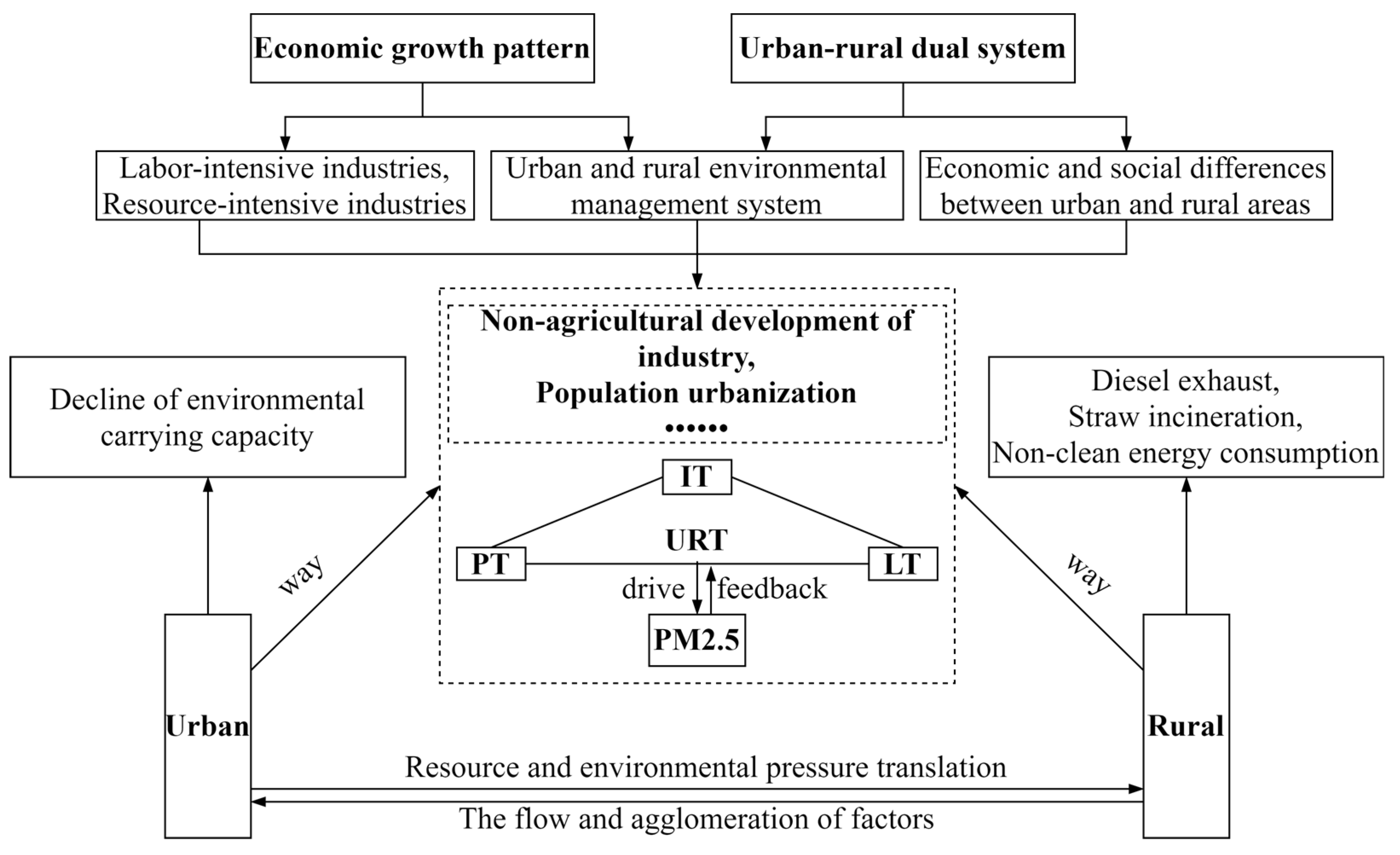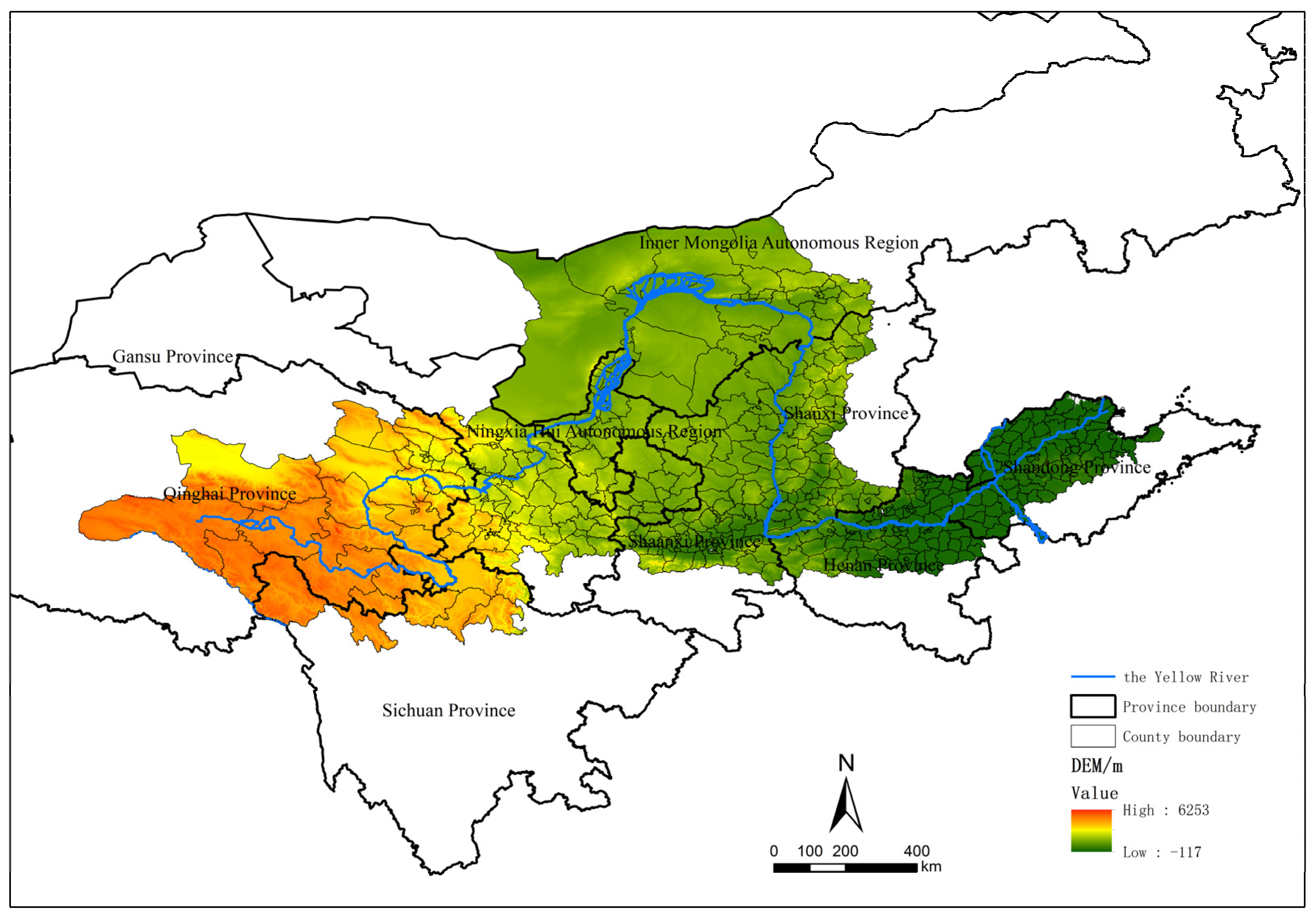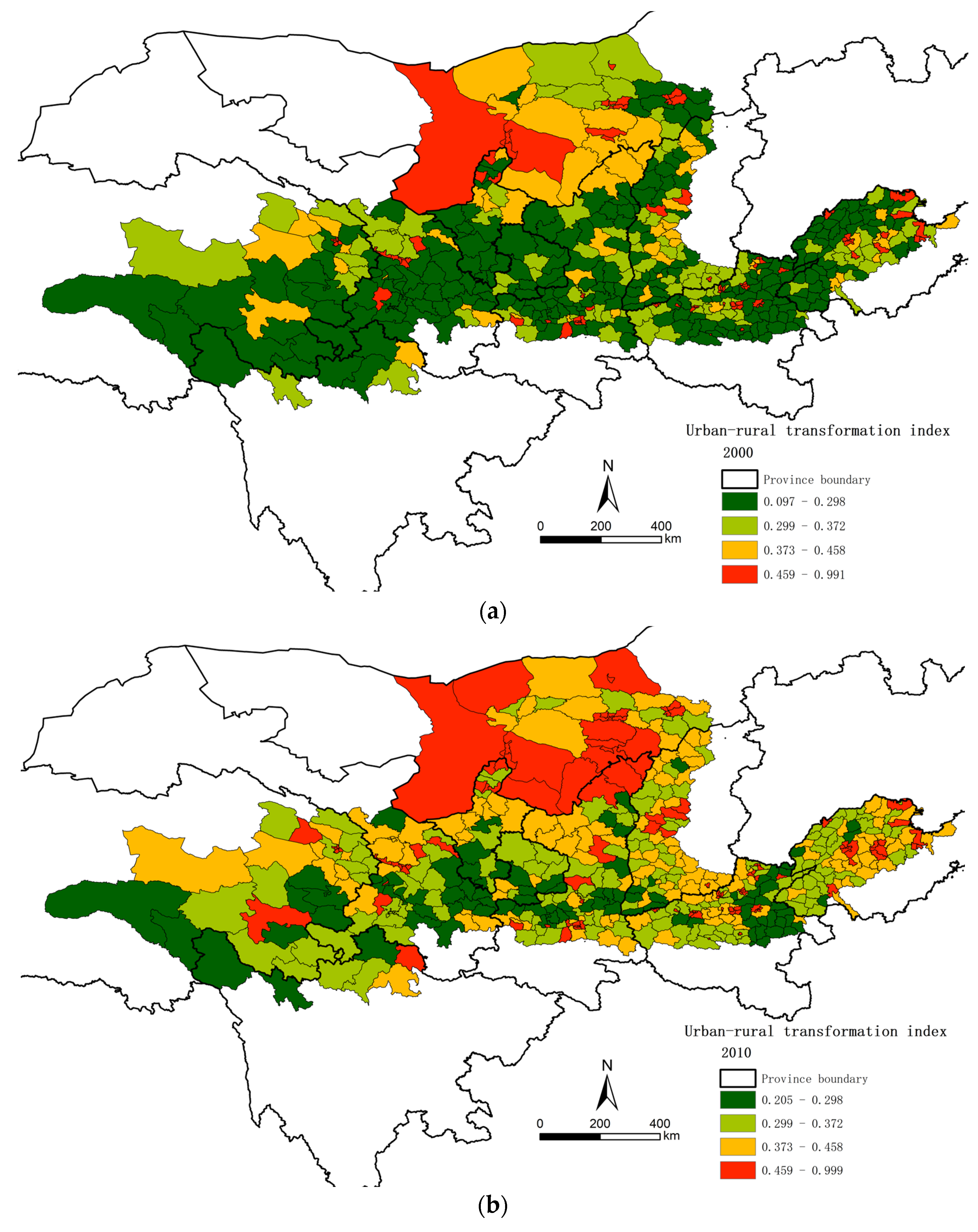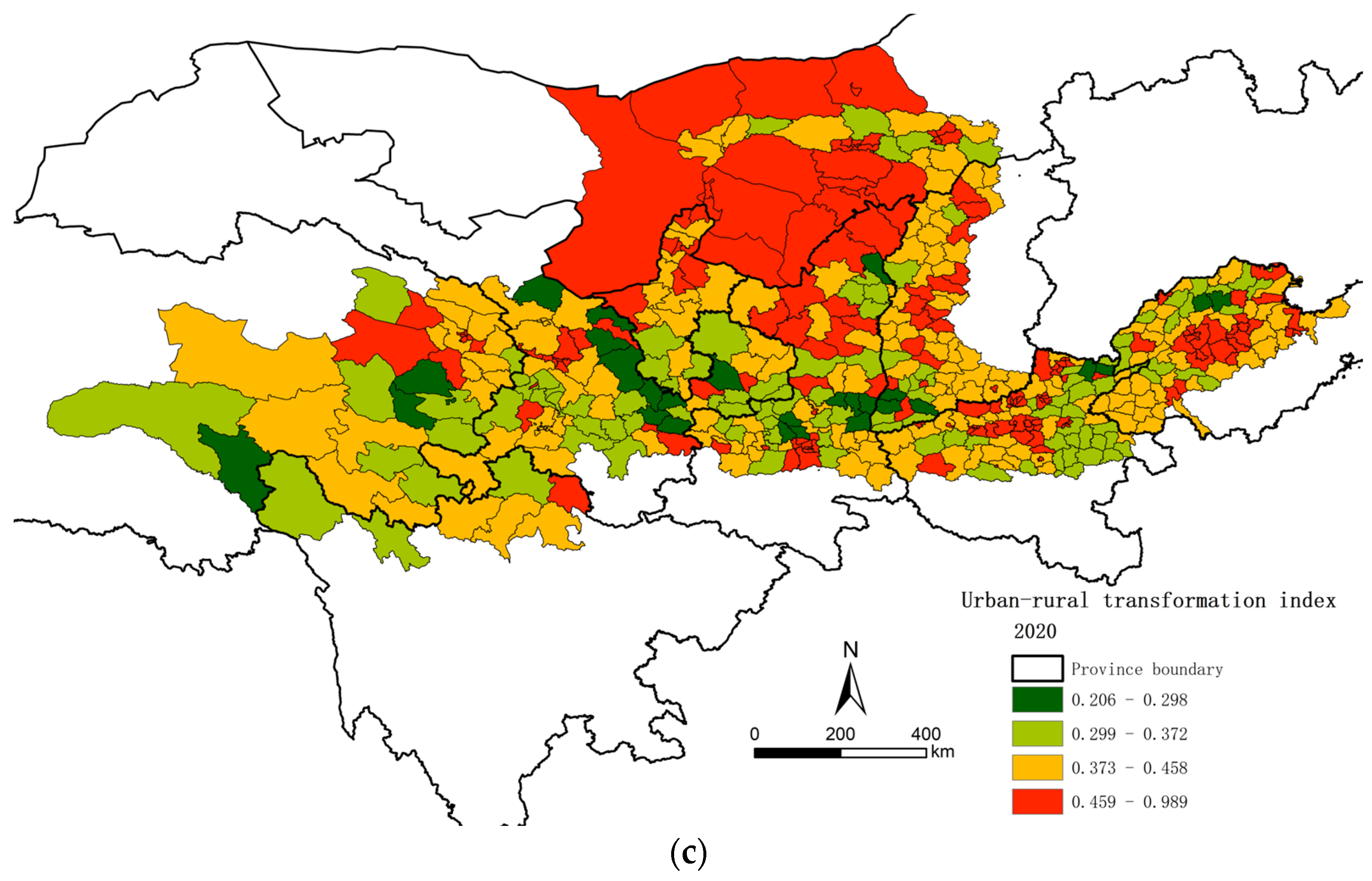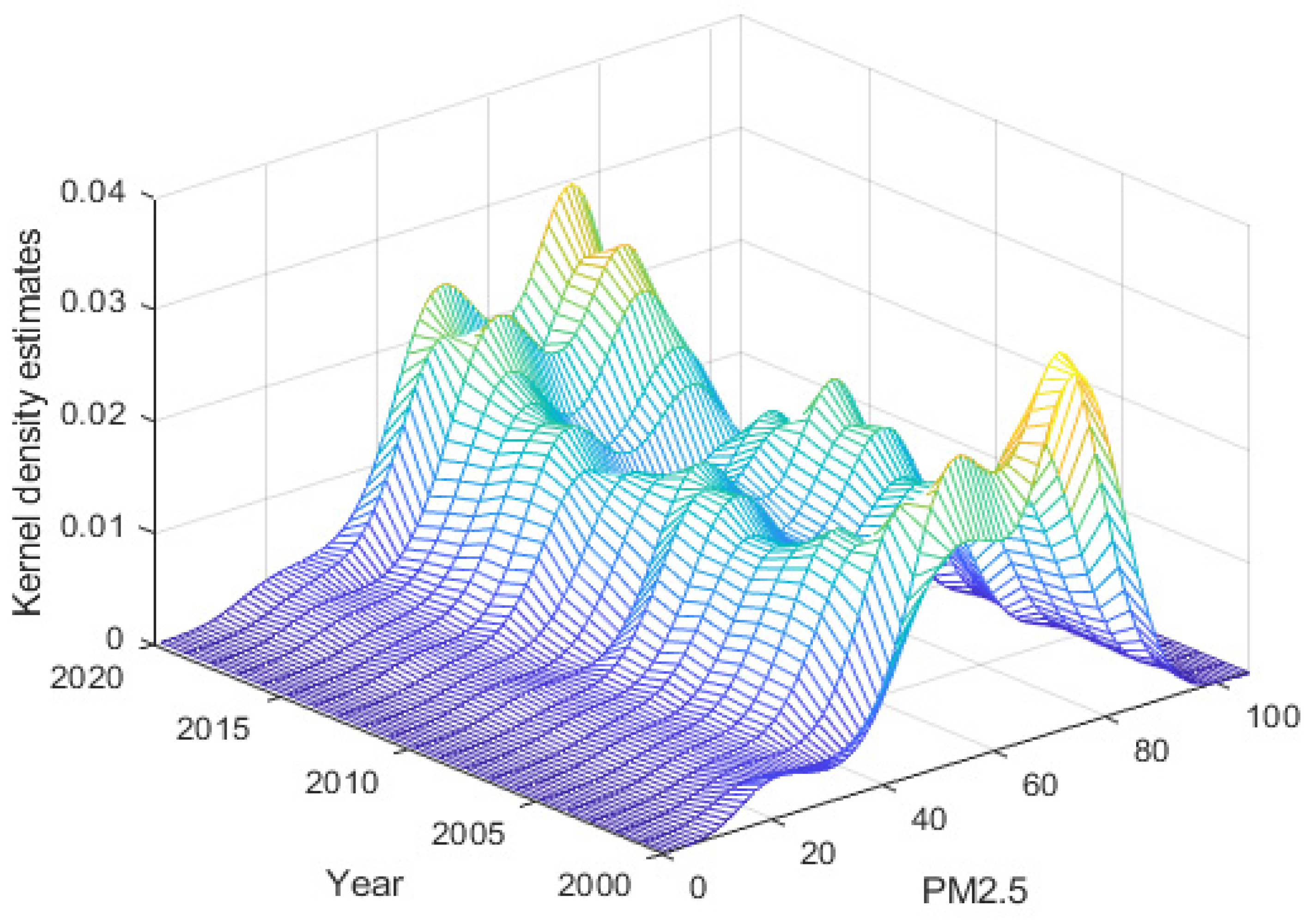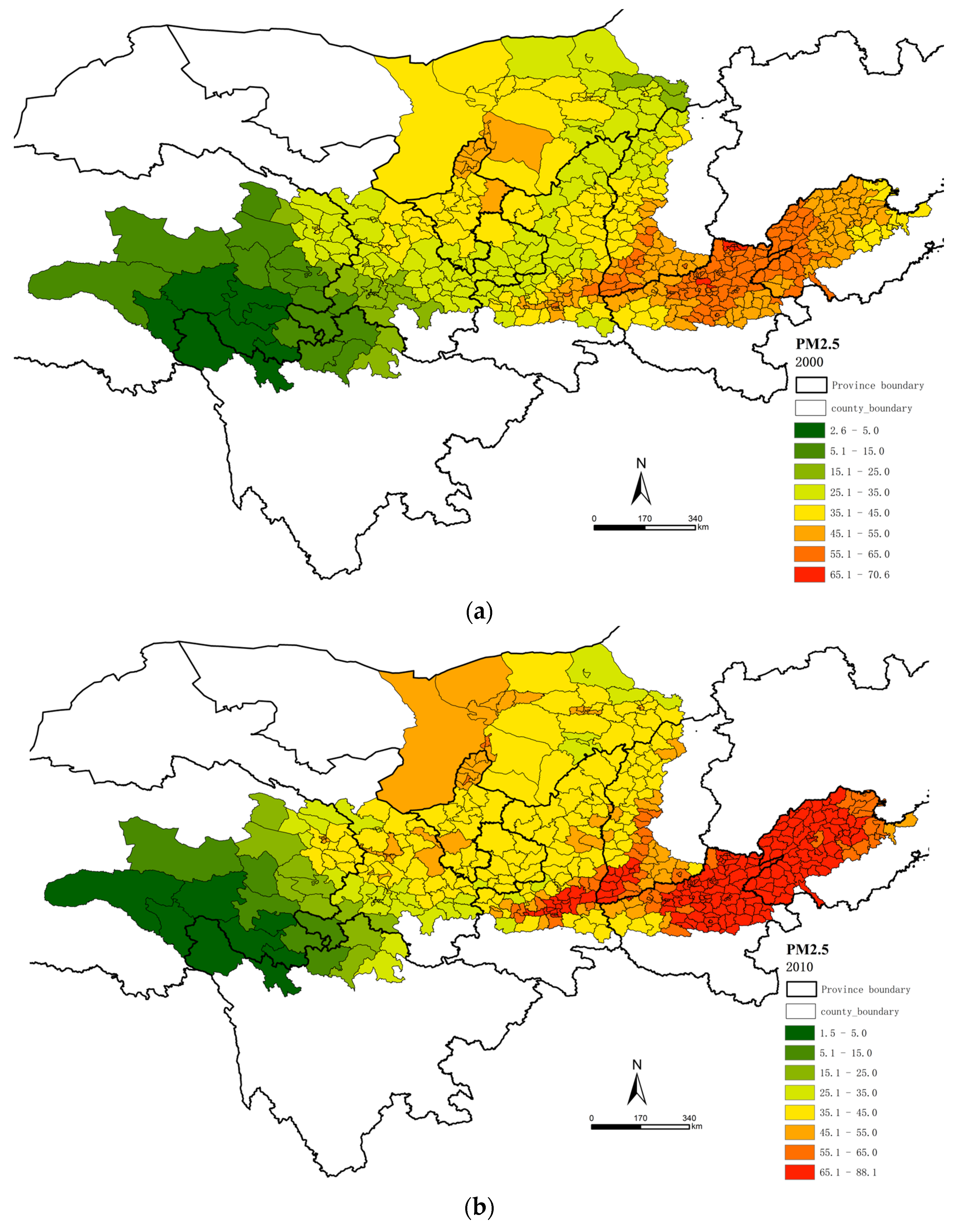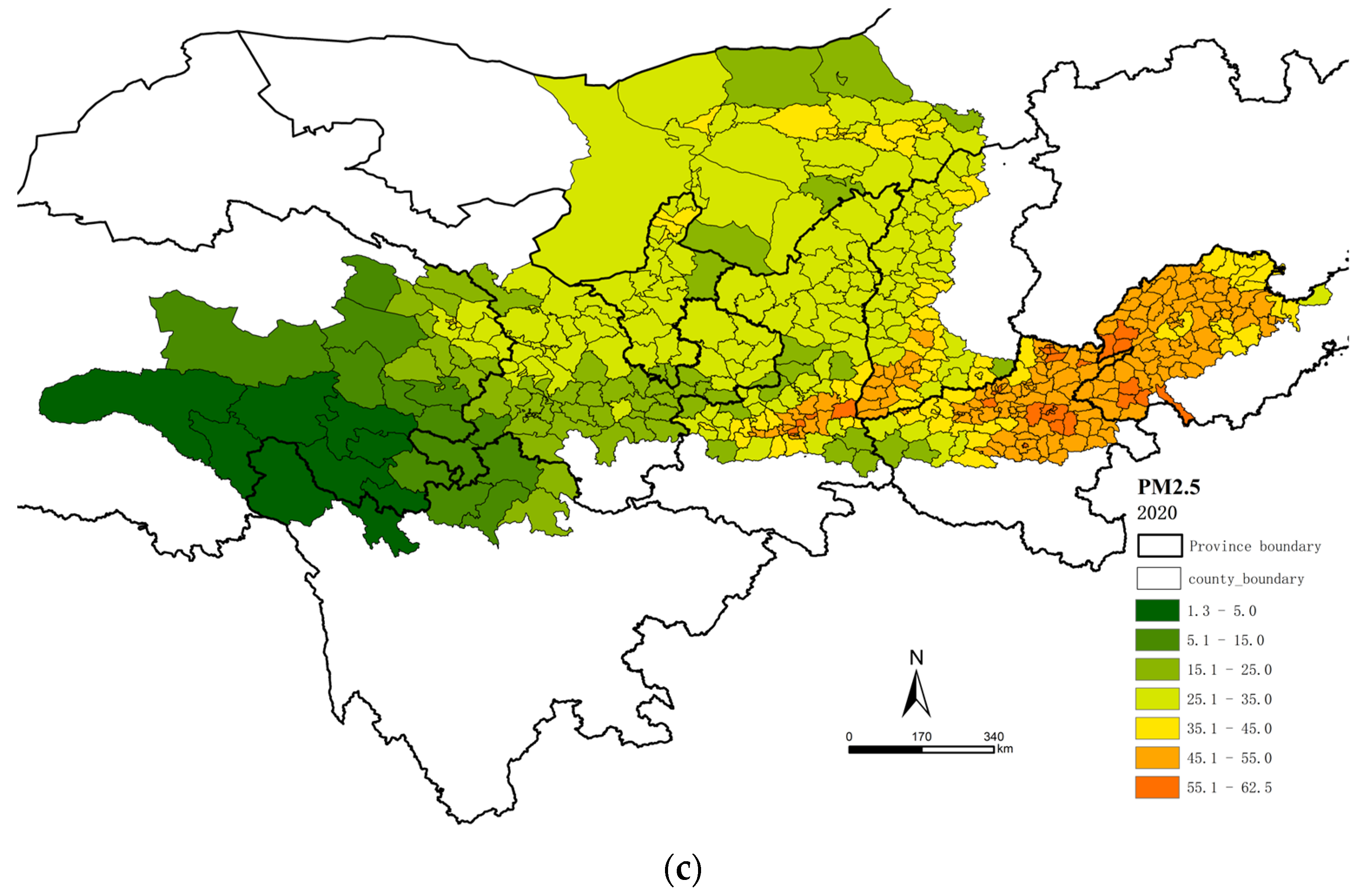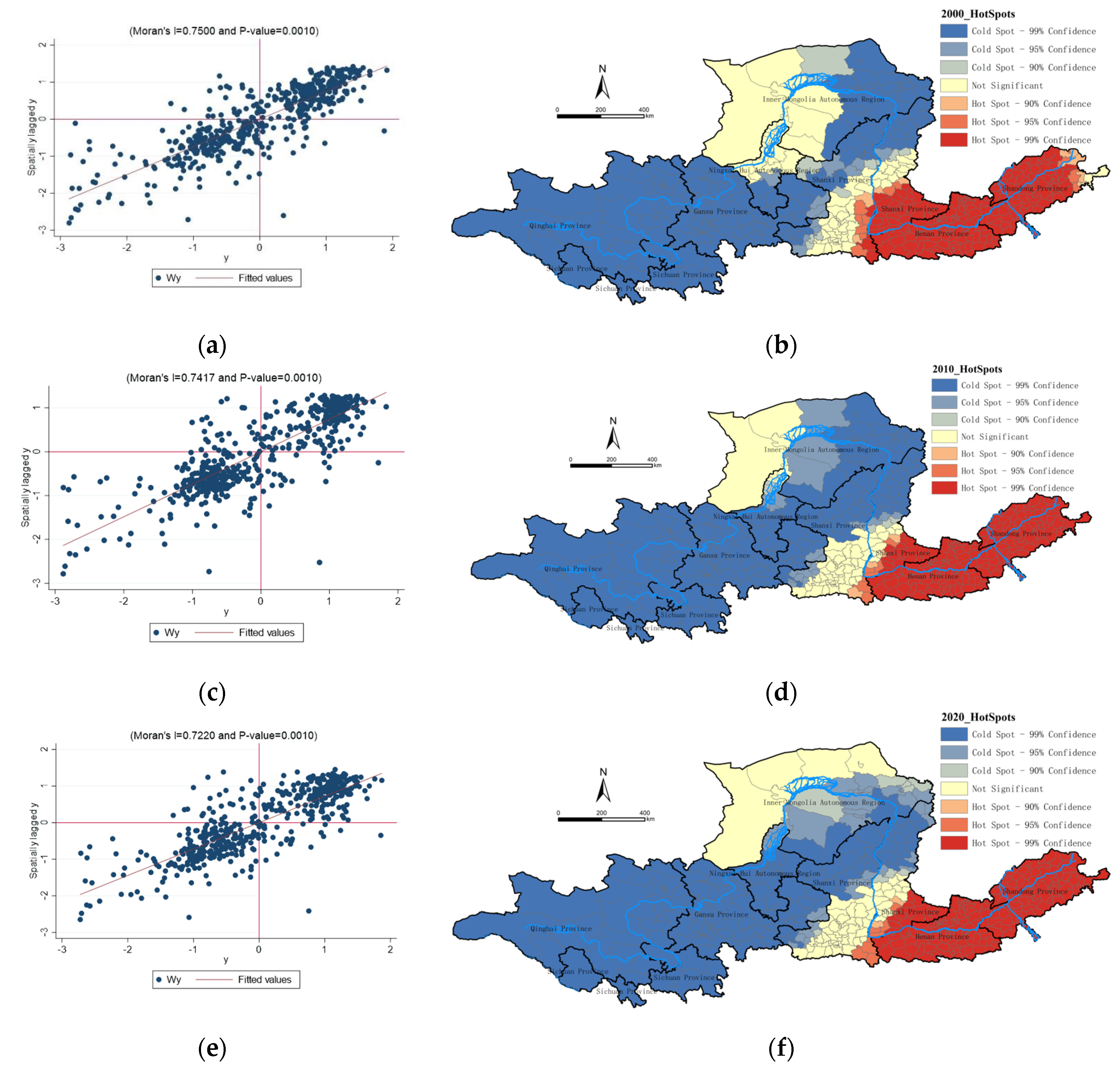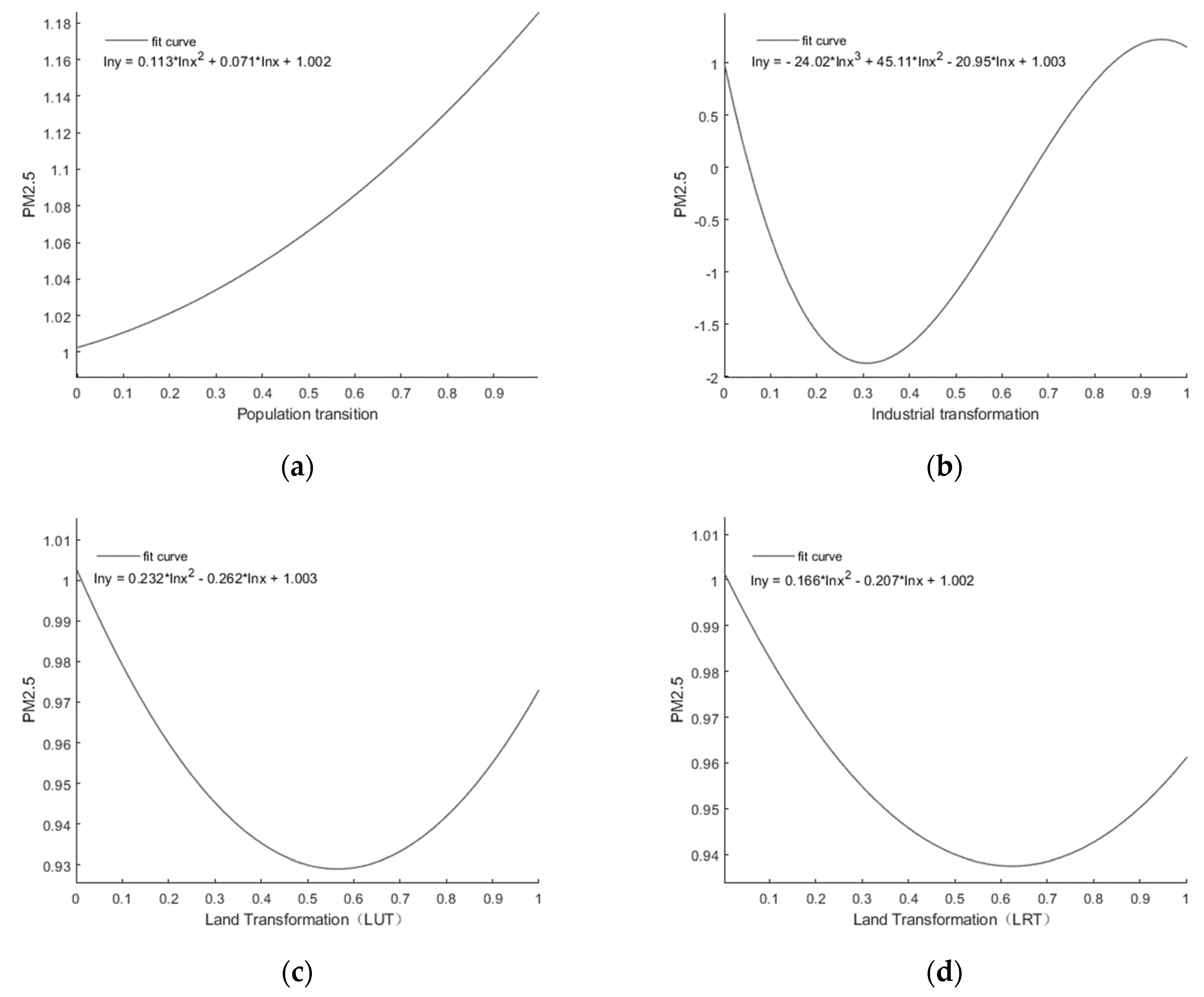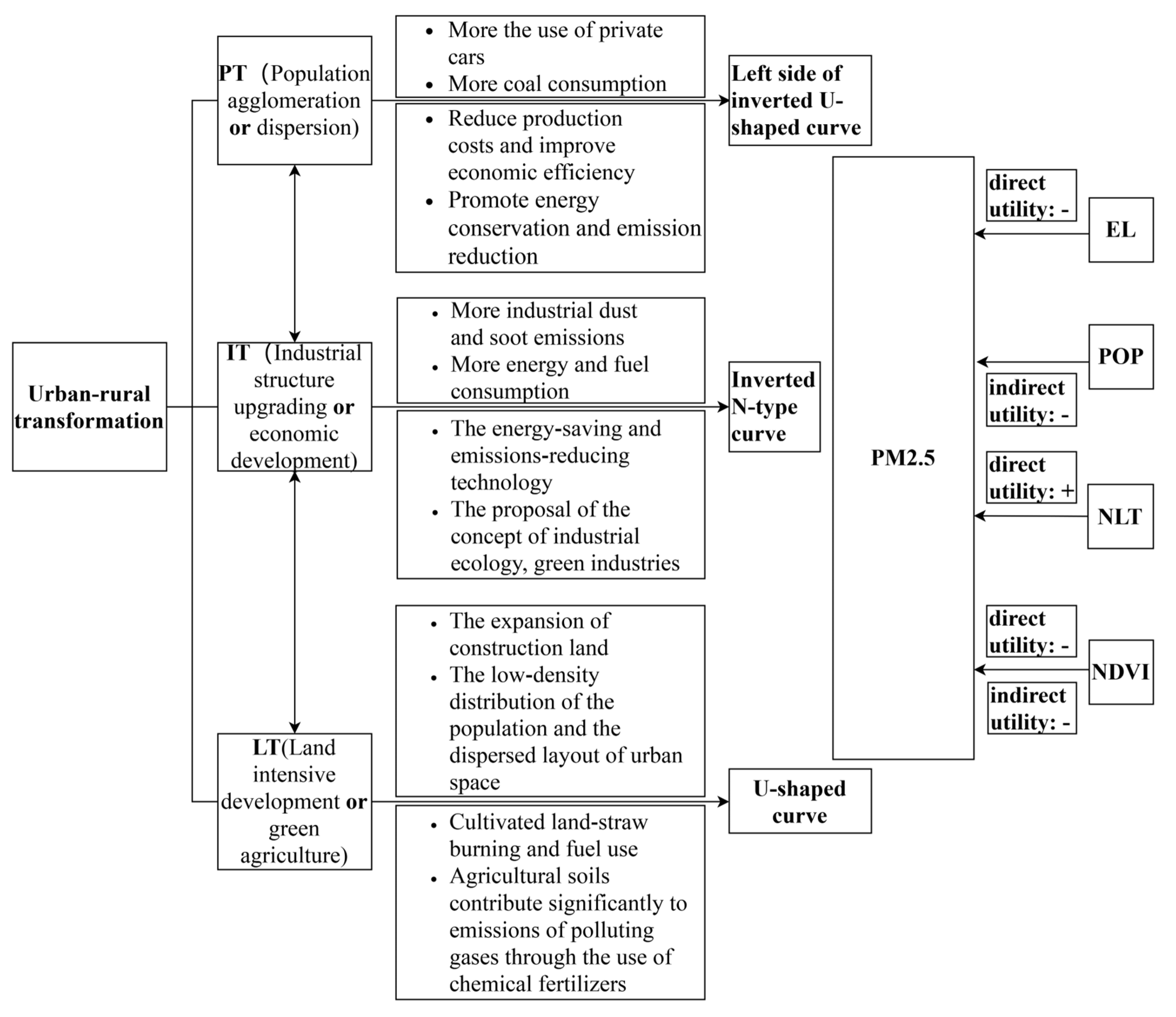1. Introduction
Cities often drive global economic development, whereas rural areas generally supply the resources they need while bearing the resulting environmental pressure [
1]. Based on the report, there is predicted to be a 1.76 billion increase in the world's urban population from 2000 to 2024, with developing countries expected to account for 86% of this rise. [
2]. However, extensive and rapid urbanization has spawned many environmental problems, among which air pollution is particularly serious [
3,
4]. In particular, haze pollution, mainly in the form of PM
2.5 emissions, is most prominent. In response to these changes, the Chinese government established a new ambient air quality standard (GB3095-2012) in 2012; it states that primary PM
2.5 concentrations cannot exceed 15 μg/m
3 and secondary PM
2.5 concentrations cannot exceed 35 μg/m
3. Although China has made some progress in reducing PM
2.5 pollution, it still lags behind Japan, the United States and other developed nations. According to the World Health Organization’s (WHO) Global Air Quality Report 20202022, the average annual concentration of PM
2.5 in China consistently exceeded five to seven times the health standard set by the WHO (≤5 μg/m
3) (
https://www.iqair.cn) and the current situation of PM
2.5 emissions remains pessimistic. Even though the Yellow River Basin's natural environment has improved, the area still has several ecological challenges. Contributing significantly to China's social and economic development and ecological security, the Yellow River Basin is vital to the country's basic industries, energy, chemical industry, and other sectors. The CPC Central Committee and the State Council in 2020 pointed out that the Yellow River has a poor ecological background, weak resource endowments, and environmental carrying capacity, as well as deep environmental pollution. In 2022, the Ministry of Ecology and Environment, the National Development and Reform Commission, the Ministry of Natural Resources, and the Ministry of Water Resources issued an Ecological and Environmental Protection Plan for the Yellow River Basin, which declared that ensuring air quality standards in key areas and improving the level of air pollution control were key priorities. Due to its long history of agricultural production, the Yellow River Basin has a dense population and industry. Thus, its air quality has been in a state of severe decline for many years [
5]. Rapid urbanization drives the population–land relationship and urban-rural development in the Yellow River Basin, especially as it regards typical ecological problems such as water and air pollution caused by rapid urbanization and industrial development in its middle and lower reaches, and thus is a region in which population, natural resources, and environmental conflicts are highly concentrated [
6]. Therefore, this study takes the Yellow River Basin as the research object, summarizes the spatiotemporal characteristics of air pollution during its urban-rural transition period, and further examines its influencing mechanisms. The research results are conducive to the sustainable, high-quality development of the Yellow River Basin. They can provide a reference for decision-makers in densely populated developing countries suffering serious air pollution.
During the urban-rural transition, problems such as rural economic weakness, environmental pollution, and resource shortages have been experienced worldwide [
7]. However, the urban-rural transition is inevitable [
8]. Researchers have studied the fundamental nature, objective, and components of urban-rural change. Liu, Long, and other academics assert that the core of the urban-rural transition is facilitating the fundamental overhaul of industrial, agricultural production, and urban-rural dynamics [
9,
10]. Industrial development, land transformation, and population transition are important components of rural spatial transformation [
11]. The research on urban-rural transformation has also shifted from focusing on single-factor analyses of land transformation [
9], industrial development [
12], and the population transition [
13] to the systematic exploration of a multifactor transformation that includes people, land, and industry [
2,
14,
15,
16]. Scholars have also studied the resource and environmental problems associated with the urban-rural transformation. Due to weak environmental management in rural areas, urban pollution has gradually been transferred to rural areas. Many enterprises with high energy consumption, heavy pollution, or that are difficult to regulate will relocate to or discard untreated waste in rural areas. In addition, rural air pollution is aggravated due to straw burning and related farming practices [
1,
17,
18]. Urban-rural areas are inseparable after their integration, and only by placing equal emphasis on both can sustainable development be achieved [
19,
20]. Hence, giving equal importance to controlling pollution in both urban and rural areas is imperative. While previous research has made progress in comprehending urban-rural change and conducting a qualitative analysis of the associated resource and environmental concerns, there is a scarcity of studies investigating the quantitative correlation between these two factors. Moreover, the research concerning the urban-rural transformation in the Yellow River Basin is inadequate, with a specific absence of knowledge regarding its impact on air pollution and the underlying causes.
PM
2.5, as the main pollutant that causes haze, not only reduces visibility but poses a serious threat to human health [
21]. As more attention is being paid to air pollution, there have been notable achievements in related research. Cheng et al. pointed out that the Gangetic Plain of India and central and eastern China (i.e., the Yellow River Basin regions) are the most serious PM
2.5 pollution areas globally [
3]. At present, the research on PM
2.5 mainly involves the nature, sources of PM
2.5 [
22,
23] as well as its spatial agglomeration characteristics and spatial heterogeneity [
24,
25]. The temporal and spatial characteristics of PM
2.5 were studied using such methods as spatial autocorrelation and ellipse of standard deviation [
26,
27,
28]. Various techniques such as geographical weighted regression, geographical detector, spatial econometric models, and random forest have been employed to analyze the components that influence PM
2.5 [
29,
30,
31,
32,
33,
34]. The influencing factors of PM
2.5 encompass various natural factors such as terrain, altitude, and others [
20,
32]. Additionally, economic development, population density, industrial structure, foreign direct investment (FDI), scientific and technological inputs, social activity intensity, municipal transportation, energy consumption, environmental regulation, urban landscape, urbanization, and other social and economic factors also play roles in PM
2.5 levels [
35,
36,
37,
38]. However, the current discussion on the impact of urbanization on PM
2.5 is mostly based on city-level analyses. In addition, the approach to controlling air pollution commonly adopted in China focuses on treating its symptoms. It thus lacks systematic, comprehensive, and holistic considerations of factors in urban-rural areas.
Studying the factors that cause the change from rural to urban areas and how they affect the levels of PM2.5 pollution is crucial for achieving sustainable development. Nevertheless, our current comprehension of the factors that drive the impact of the shift from urban to rural areas on air pollution remains inadequate. This study focuses on 498 counties in the Yellow River Basin, which are considered representative locations. This study uses extensive county-level data to examine the spatial and temporal patterns of urban-rural change and its impact on air pollution. It employs several approaches to analyze the integration of urban and rural areas completely. The purpose of this study was to (1) measure the level of the urban-rural transformation in the study area, (2) accurately assess the overall level of air pollution in the Yellow River Basin, and (3) explore the influencing mechanisms of the urban-rural transition on air pollution. This study aimed to elucidate the multidimensional relationships and patterns between land, population, industrial transformation, and PM2.5 at the county level to support the formulation of regional PM2.5 emission reduction policies and provide a reference for decision-makers in densely populated and severely polluted regions worldwide.
5. Discussion
Air pollution is a cross-regional problem with complex formation mechanisms. The key to promoting urban-rural integration and economic development while protecting the environment is quantitatively assessing the level of urban-rural transformation and the temporal and spatial variations of PM2.5. Furthermore, it is crucial to evaluate the driving mechanism behind urban-rural transformation and its impact on changes in PM2.5 concentration. The empirical findings will be discussed in the following parts:
The urban-rural transformation measured in this article emphasized the coordination of urbanization and ruralization. To a certain extent, it embodies the overall process of agricultural and rural modernization [
52]. The urban-rural change in the Yellow River Basin has a spatial pattern characterized by high levels in the northern and eastern regions and low levels in the southern and western regions. The counties with High or Higher index values are mainly distributed in Inner Mongolia and near the capital city of each province. This could be attributed to the proximity of the counties around the provincial capital to the economic hub of the province. As urban-rural integration progresses, the connection between urban and rural areas is growing stronger, and rural areas are greatly influenced by the influences originating from metropolitan centers. The counties with Low or Lower index values are mainly distributed in the western part and the border areas of each province. This may be because counties in the provincial border regions are affected by their spatial location as well as administrative barriers and policies. Most of the border regions are at the “end” of each province’s economic system regarding geography and their integration into high-level regional development strategies, resulting in inefficient and slow development. This indicates that large cities can promote urban-rural transformation, but their range is limited. In the future, attention should be paid to these edge areas at the “end” of each province’s economic system. It is therefore recommended to break down administrative barriers, form a joint force, and promote cooperative development by leveraging each region’s advantages.
- 2.
Take integrated and localized measures to control air pollution.
PM2.5 in the Yellow River Basin shows a clear spatial correlation, thus indicating the need for regional collaboration to control air pollution. To enhance the collective efforts in preventing and controlling regional air pollution, it is imperative to promote awareness of urban-rural integration in the future. “High–high” aggregation areas are mainly concentrated in the eastern part of the region, with the Henan and Shandong provinces being the most heavily affected regions. This suggests that air pollution in these areas is particularly severe, and localized ecological restoration policies should be established accordingly.
- 3.
The influencing mechanisms of PM2.5 by different subsystems of the urban-rural transformation vary.
According to the research results, the impact of IT on PM2.5 has the highest elastic coefficient, thus indicating that the industrial structure plays a dominant role in the spatiotemporal evolution of PM2.5. Specifically, the impact of IT on PM2.5 shows an inverted “N-shaped” curve. This indicates that different stages of industrial transformation have different effects on air pollution, and the relationship between IT and PM2.5 is shifting from positive to negative. This could be attributed to the transformation of the Yellow River Basin industry from a factor-driven model to a green technology-driven model. In the future, it may be necessary to abandon economic models that do not consider the environment and continue accelerating industrial restructuring and transformation through innovative green technologies in counties to create a sustainable industrial system in the Yellow River Basin.
Regarding the impact of PT on PM
2.5, excessive rural-urban population aggregation leads to insufficient public resources, traffic congestion, and high energy intensity, resulting in a continued rise in PM
2.5. It should be noted that some studies have pointed out that the spatial aggregation of the population can reduce production costs and improve economic efficiency, promote energy conservation and emissions reduction, and improve the overall air pollution situation, thereby reducing the pollution caused by PM
2.5 emissions [
43]. According to the principles of urban economics, moderate population aggregations can reduce atmospheric pollution. The impact of PT on PM
2.5 will appear as a downward sloping trend (i.e., the left-hand side of the “U-shaped” curve). In the future, the spatial layout of the population and the carrying capacity of resources and environment should be considered overall, and the spatial planning of the land should be scientifically formulated.
Regarding the influence of LT on PM
2.5, the relationship between LUT, LRT, and PM
2.5 exhibits a “U-shaped” curve. The uncontrolled expansion of construction land results in a scattered layout and low land use efficiency, resulting in pollution problems in many counties. The increase in the proportion of cultivated land will also aggravate atmospheric pollution, which indicates that soil and air pollution influence each other, creating a pollution cycle [
17]. In the future, it is urgent to ensure purposeful development, redefine Urban built-up area boundaries according to scientific findings, and rationally expand cities while preventing their uncontrolled expansion. Decision-makers should firmly grasp the concept of safe, efficient, ecological, and high-quality urban land space planning, strengthen land use controls and ecological red lines, and include urban construction land and ecological preservation land in national spatial planning [
44]. Furthermore, it is imperative to consider the three-dimensional effect of soil pollution, restrict the emissions of harmful gases from agricultural land through active land management, and vigorously develop green agriculture, which will benefit the economy, ecosystems, and human health in urban-rural areas of the region.
6. Conclusions
This study utilized remote sensing imagery and panel data collected from counties in the Yellow River Basin between 2000 and 2020 to create an index measuring urban-rural change. The spatiotemporal pattern was revealed using the entropy approach and AHP hierarchical analysis. In addition, spatial autocorrelation was employed to examine the spatiotemporal properties of PM2.5, while spatial econometric models were utilized to study the non-linear correlation and influencing processes between the urban-rural transformation and PM2.5. The main conclusions are as follows.
From 2000 to 2020, the urban-rural transformation in the Yellow River basin has shown a clear upward trend. From a spatial distribution perspective, it has evolved from high in the north and the east and low in the south and the west to high in the north and balanced in the east, middle, and west, and the interregional differences are gradually narrowing. Counties with High or Higher indexes are mainly distributed in Inner Mongolia and the counties around cities in various provinces, while counties with Low or Lower index values are mainly distributed in the western and peripheral areas of various provinces.
PM2.5 showed inflection points in 2006 and 2015, with a trend of first rising, then fluctuating around a high baseline, then gradually decreasing. PM2.5 in the Yellow River basin generally exhibits a spatial pattern that is high in the east and low in the west, and “high–high” clusters are mainly concentrated in the eastern regions, thus indicating that Henan and Shandong provinces have high concentrations of haze, while “low–low” clusters are mainly concentrated in the western part of the region.
Different stages in the development of various subsystems of the urban-rural transformation have different impacts on PM2.5. The impact of IT on PM2.5 exhibits an inverted “N-shaped” curve of negative-positive-negative changes, and the industrial structure plays a controlling role in the spatiotemporal evolution of PM2.5. Presently, the influence of the PT on PM2.5 has taken the form of the left extremity of an inverted "U-shaped" curve. A "U-shaped" relationship illustrates the effect of LT on PM2.5.
Regarding direct effects, IT, LRT, and NLT all have a positive impact on PM2.5, while EL and NDVI have a negative effect on it. Regarding indirect effects, LT (LUT, LRT) has a positive impact on the PM2.5 of adjacent areas, while NDVI and POP have a negative effect on it.
This research offers a novel approach to examining the correlation between urban-rural change and PM2.5 within urban-rural integration. Implementing PM2.5 emission reduction measures in the Yellow River Basin promotes sustainable and high-quality development. Furthermore, it can serve as a valuable resource for policymakers in densely populated regions that experience significant air pollution, particularly in developing nations.
